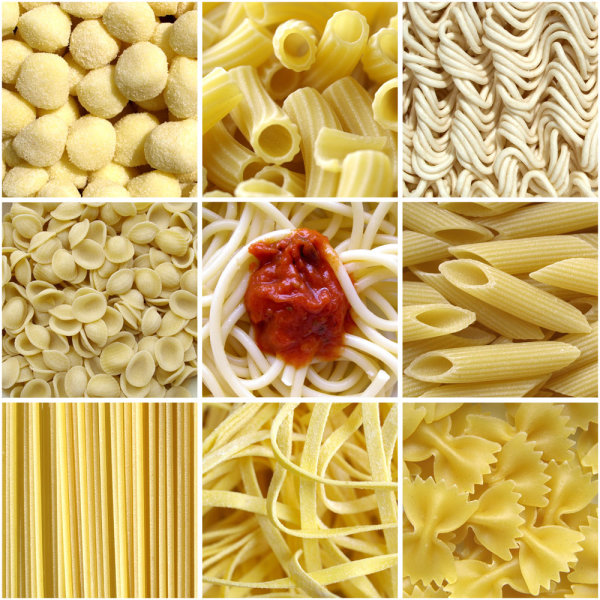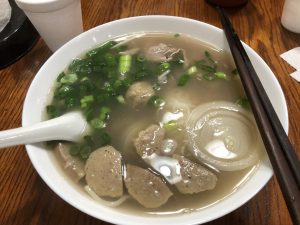Abstract:
Chinese food has a long history in the United States. Immigrants from China first came to the country for work and brought their recipes for food along with them. They focused on jobs in the service industry due to discrimination. As a result, Chinese restaurants had to adapt their recipes because of the lack of native ingredients and to accommodate the tastes of Americans. This resulted in a new American Chinese cuisine that had heavy influences of American cooking and ingredients. This also resulted in famous creations such as chop suey, chow mein, and General Tso’s chicken. While Americans have considered these creations to be prevalent in China, in reality they are American inventions that satisfy the desire of an exotic food conforming to the American palate. However, traditional Chinese cuisine remains in the United States within the homes of family immigrants, and these dishes often have a significance to them that is passed down throughout generations of the family. Chinese immigrant families do eventually become accustomed to Western diets due to assimilation to the once-foreign country. While American Chinese cuisine has diverged significantly from traditional Chinese cuisine, authenticity is more important than ever as these traditional dishes continue to hold special meaning to immigrant families.
Thomas Nguyen
Professors Ristaino and Li
Italian/Chinese 370W
8 August 2019
The Development of Chinese Cuisine in the United States
The United States is often known as a multicultural country with various ethnic groups that have immigrated for new opportunities and called the land as their home. While these ethnic groups would assimilate to American society, they would still attempt to maintain their culture and customs. One of the ways they would retain their culture is through cuisine, and in particular, the Chinese have brought their food to the United States. Today there are tens of thousands of Chinese restaurants that are commonplace in the United States (Lu 1995). However, these restaurants are not true representations of Chinese cuisine. Because of the difference of dietary preferences between the two cultures, American Chinese food is drastically different from traditional Chinese food, and it has emerged as its own distinct cuisine with its own ingredients and flavors that appeal to American tastes. While American Chinese cuisine continues to be popular in the United States, traditional Chinese cuisine still exists in select local restaurants and in the homes of Chinese immigrant families and Chinese-Americans maintaining their original culture.
Chinese immigrants had first arrived in the United States in the early 1800s to work in low-income jobs such as mining and railroad construction (Zong 2017). Their labor had a profound effect on the growth of the United States as a country after the Civil War such as with the development of the transcontinental railroad. While setting into the relatively new country, the Chinese faced backlash among their white counterparts, becoming as extreme as the passing of the Chinese Exclusion Act of 1882 to limit Chinese immigration into the United States. As a result of the discrimination, the Chinese immigrants would form enclave communities, resulting in Chinatowns in major cities like San Francisco. They also focused on jobs in the service industry such as laundromats and restaurants. To remember their culture in a foreign land, the immigrants would use recipes from home as a way to maintain their heritage. As part of their culture, food is essential to a healthy life and helps to strengthen family and community times as this was especially important in an ethnic enclave. Chinese restaurants would provide this sense of community while at the same time introducing Chinese food to the United States.
However, traditional Chinese cuisine has flavors and ingredients that would otherwise be unfamiliar or unavailable in the United States. As a result, Chinese restaurants had to adapt with the available ingredients and create dishes that suited the typical American palate. Ingredients such as broccoli, carrots, and onions are familiar American vegetables used in cooking when they would otherwise be unfamiliar in China (Lu 1995). Savory flavors would be modified to sweeter flavors to satisfy American tastes. As more Chinese restaurants opened throughout the country, the foods served at these restaurants would greatly diverge from traditional cuisine to the point that they would be unrecognizable to Chinese people. This “Americanization” of Chinese food has resulted in variations of traditional dishes and even new creations such as General Tso’s chicken and fortune cookies (Lu 1995). As a result, a distinct American Chinese cuisine emerged, and it has since become incredibly popular in the country for its American take on a once-exotic cuisine.
When making these foods, Chinese restaurants in America had to adapt to what was available for them. Not only was the palate of their customers different but also the resources they had. In modern times, the balance between cost and quality is essential to maintain a customer base (Lu 1995). American Chinese dishes would use American vegetables that were locally available such as broccoli and carrots to satisfy customer needs and save money. Restaurants would also sacrifice authentic Chinese vegetables such as bamboo shoots due to their relatively more expensive cost and distaste among American customers. Cooking methods are also different in preparing American Chinese food. Restaurants focus on efficiency to accommodate the fast-pace of American life with quicker cooking methods, fewer ingredients, and incredibly hot stoves (Lu 1995). As a result, these American Chinese dishes lose the “authenticity” of traditional Chinese dishes. Customers who value traditional Chinese food will attempt to find it, and the concept of “authenticity” is used to attract customers who are tired of the “Americanized” Chinese food and seeking for a more truthful version of it (Lu 1995).
One of the most popular American Chinese dishes that represents this process is chop suey. It is a dish with no specific recipe or set of ingredients; rather, it is a mixture of different vegetables and meat stir-fried together with a thick sauce served over rice or noodles. The word “chow” in Chinese means “to stir-fry,” and together as “chop suey,” it means “animal intestines” (Liu 2009). This seemingly unappealing name reveals a cultural value of traditional Chinese cuisine of not wasting meat as much as possible. However, to appeal to American tastes, Chinese cooks would instead use a mixture of ingredients that were acceptable to Americans such as chicken and mushrooms. Due to the adaptability of the dish, chop suey became famous throughout America as an accessible Chinese dish. This resulted in a wave of popularity for the dish, spreading to major cities in the United States starting from the Chinatown of New York and all the way to San Francisco (Liu 2009). However, Americans had eventually realized that the chop suey familiar to them is not truly authentic, and that it is a virtually unknown dish in China (Liu 2009). Chop suey had become so disconnected with traditional Chinese cuisine that it had essentially become an American dish with a foreign name.
Noodle dishes of China have also undergone this process of “Americanization.” Chow mein and lo mein are both iconic dishes of American Chinese cuisine that have been modified from traditional Chinese noodles to appeal to the American taste. “Chow mein” means “stir-fried noodles” while lo mein means “tossed noodles.” Both of these dishes consist of egg noodles that are quickly cooked in a wok in a sauce with a mixture of meat and vegetables. However, the difference between the noodles is the method of cooking. Chow mein is made by stir-frying the noodles, resulting in crunchier noodles and highlighting the American preference for fried foods (Lu 1995). On the other hand, lo mein is pulled and tossed; this results in a softer texture to the noodle (Cappiello 2019). Lo mein usually has more vegetables and sauce compared to chow mein and has distinctive flavors rather than a blend that chow mein possesses. Interestingly, unlike most of American Chinese food, lo mein actually has an authentic counterpart in China. However, in China it is cooked with a thinner sauce with fewer ingredients and served with more vegetables such as bok choy and cabbage (Wilson 2018).
General Tso’s chicken is a popular American Chinese dish that also had its origins purely in the United States. Inspired by a famous military general in China, General Tso’s chicken has become a symbol of American Chinese food perceived to be of Chinese origin. The dish is well-known for its tangy sauce and crunchy texture. A chef named Peng Chang-kuei invented the recipe based on his own influences from the Hunan province of China (Hosking 2006). Hunanese cuisine is typically savory with an emphasis on salty and sour, but in order to appeal to American taste buds, Peng had to modify his recipe by including plenty of sugar atypical of Hunanese cooking. He also deep-fried the chicken to appeal to American preference for fried foods despite the cooking technique being uncommon in Hunan. These changes resulted in what is now called General Tso’s chicken: a sweet and savory dish with a crispy texture iconic among Chinese restaurants in America. The dish also inspired imitations around the world, even in Hong Kong (Hosking 2006). However, Americans have become so accustomed to this seemingly exotic dish that they forget the questionable authenticity of it from its ingredients to even the origins of its name.
However, traditional Chinese dishes continue to exist in the United States within the homes of immigrant families. These families cater towards their own members and are not forced to adapt their recipes to American influences. For instance, ping an mien is a noodle dish that is not found in typical American Chinese restaurants. Susanna Chen recounts her experience with ping an mien and her family in the United States (Chen 2014). The noodle dish is a family tradition passed through multiple generations. At first, Chen did not care much of the dish until her boyfriend had to leave for his studies. The name ping an mien means “peaceful noodles” and is made when sending someone far away (Chen 2014). In order for Chen to make the noodles, she had to consult her mother for the recipe and go to the supermarket to obtain the necessary ingredients. Despite not making it perfectly according to her mother’s given instructions, Chen manages to recreate not just an authentic Chinese dish from her family, but also a meaningful one with a tradition that bonds loved ones together when they depart. These family recipes are the truly authentic dishes of Chinese cuisine in the United States. Unfortunately, Americans who are accustomed to American Chinese cuisine would most likely not recognize this as a traditional dish, especially one with such a special meaning to Chinese families.
However, Chinese immigrant families in the United States are not completely immune to Western influences in their diet. Despite the immigrants’ maintaining their culinary traditions, assimilation gradually but eventually occurs as they are in a foreign land. According to a study conducted by Jessie Satia and colleagues in Seattle, many Chinese households who had not completely assimilated into American culture had Western foods such as butter and snack chips (Satia 2001). Families who have high-fat foods in their household “had higher-fat dietary behavior” indicative of Western diets (Satia 2001). Although assimilation occurs to ethnic groups in a foreign country, the Chinese families still attempt to maintain their traditions through food but have also adapted to the foods available to them in the new country.
Chinese food in America has adapted to its new culture through various changes resulting in American Chinese cuisine. This is reflected through new cooking styles and use of American ingredients to accommodate for American tastes. However, the dishes of American Chinese cuisine have lost their identity as truly Chinese dishes, making them American dishes with Chinese names to it. American Chinese restaurants have grown immensely popular over the years with successful restaurants such as Panda Express and P.F. Chang’s becoming iconic names in American fast food. The distinction between American Chinese and traditional Chinese cuisine has grown prominent over the years, and “authenticity” is valued more than ever. However, homes of Chinese immigrant families maintain traditional Chinese foods because of their familiarity and significance. A selection of restaurants also maintains certain traditions of Chinese food such as dim sum. Chinese cuisine in America is still evolving, taking influence from American cuisine, but traditional Chinese cuisine still maintains its standing within immigrant families. Perhaps someday American tastes will be more open to traditional Chinese cuisines, but in the meantime, American Chinese cuisine continues to serve as the link from an “Americanized” versions of Chinese food to truly authentic ones that still hold special meaning to immigrant families.
Works Cited
Cappiello, Emily. “What Is the Difference Between Chow Mein and Lo Mein?” Chowhound, Chowhound, 21 Mar. 2019, https://www.chowhound.com/food-news/222655/what-is-the-difference-between-chow-mein-and-lo-mein/.
Chen, Susannah. “Ping An Mien, a Chinese Family Noodle Story.” Chowhound, Chowhound, 7 July 2014, https://www.chowhound.com/food-news/152845/ping-an-mien-a-family-noodle-story/.
Hosking, Richard. Authenticity in the Kitchen: Proceedings of the Oxford Symposium on Food and Cookery 2005. Prospect Books, 2006.
Liu, Haiming. “Chop Suey as Imagined Authentic Chinese Food: The Culinary Identity of Chinese Restaurants in the United States.” Journal of Transnational American Studies, 16 Feb. 2009, https://escholarship.org/content/qt2bc4k55r/qt2bc4k55r.pdf.
Liu, Junru. Chinese Food. Cambridge University Press, 2011.
Lu, Shun, and Gary Alan Fine. “The Presentation of Ethnic Authenticity: Chinese Food as a Social Accomplishment.” The Sociological Quarterly, vol. 36, no. 3, 1995, pp. 535–553., doi:10.1111/j.1533-8525.1995.tb00452.x.
Newman, Jacqueline M. “Chow Mein.” Flavor & Fortune, pp. 25–27.
Satia, Jessie A, et al. “A Household Food Inventory for North American Chinese.” Public Health Nutrition, vol. 4, no. 2, 2001, pp. 241–247., doi:10.1079/phn200097.
Wilson, Laurie. “What Is the Difference Between Lo Mein in China and in Chinatown?” Chowhound, Chowhound, 5 Apr. 2018, https://www.chowhound.com/food-news/199152/what-is-the-difference-between-lo-mein-in-china-and-in-chinatown/.
Wilson, Laurie. “What Is the Difference Between Lo Mein in China and in Chinatown?” Chowhound, Chowhound, 2 Aug. 2019, https://www.chowhound.com/food-news/199152/what-is-the-difference-between-lo-mein-in-china-and-in-chinatown/.
Zong, Jie, et al. “Chinese Immigrants in the United States.” Migrationpolicy.org, 29 Sept. 2017, https://www.migrationpolicy.org/article/chinese-immigrants-united-states.



